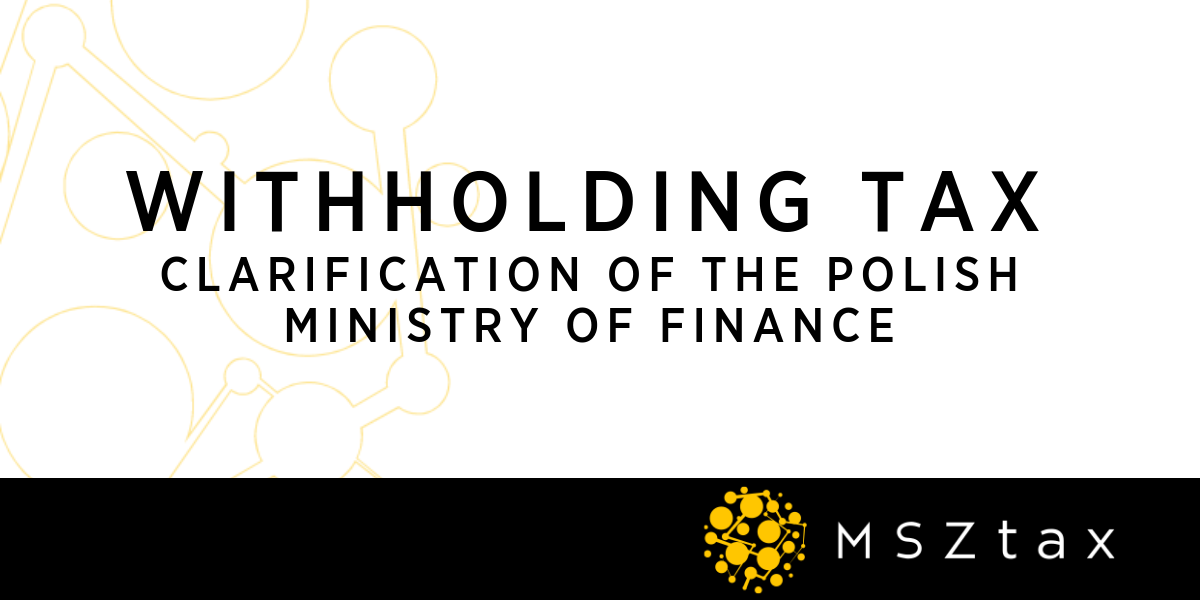Entrepreneurs who cooperate with foreign counterparties may be required to deduct withholding tax/WHT. It is not easy to determine when such a tax should be deducted. Especially since the rules are going to change as of 2019!
When should the withholding tax be deducted?
Withholding tax is a tax that must be deducted by an entrepreneur who pays remuneration to its foreign counterparties. This tax applies to payments made on account of interest, dividends, royalties and broadly understood intangible services. While the payment of dividends and interest is clear, other categories – royalties and advisory services – are much more problematic.
Royalties are fees paid for, for example, the use of computer software licenses, images purchased, know-how purchased, use of trademarks and other industrial property rights, copyrights, etc.
Wherever we pay for some intangible rights, we usually face the question of whether a withholding tax should or should not be levied.
However, once we start looking at intangible services, we will open a Pandora’s box. The definition of these services is broad and open at the same time.
As required by regulations, the obligation to collect withholding tax is to apply to the payment of fees for advisory, accounting, market research, legal, advertising, management and control, data processing and recruitment services, as well as for guarantees, sureties and similar benefits.
Withholding tax rates
There are three basic withholding tax rates:
- 19% – on dividends
- 20% – on interest, royalties, intangible services
- 10% – on certain transport services
Remember that we are talking about taxes, so it cannot be that simple! Since payments are made to foreign entities, they may be subject to double taxation treaties. If Poland has entered into such a treaty with the home country of our counterparty, we should verify whether it provides for any particular tax treatment.
Very often the treaties stipulate that the tax to be withheld is not 20% but, for instance, 5%. For some services, there may be no need to withhold any tax at all. However, in order to benefit from a treaty and preferences it provides, our counterparty must send us a tax residency certificate.
If payments are made to associated companies – it may also be possible to get an exemption from the tax!
Withholding tax mechanism
Once we have established that we have to withhold the tax and we know the applicable rate, we may proceed to calculate the tax amount. The calculation method will depend on the agreement concluded with our client and whether or not the agreement contains a so-called gross-up clause. I have prepared the following examples to show the differences.
EXAMPLE 1:
Company X pays a royalty of PLN 100,000 to its foreign counterparty for the use of a trademark. The agreement contains no provisions on WHT (withholding tax). The counterparty has not delivered its residency certificate.
Thus, Company X will pay PLN 80,000 to the counterparty and PLN 20,000 will be paid to the Polish Tax Office.
Example 2 (gross-up clause):
Company X pays a royalty of PLN 100,000 to its foreign counterparty (Company Z) for the use of a trademark. The agreement provides that “all payments due to Z shall be made without deductions. If, due to local regulations, the fee payable to Company Z is subject to taxation, the fee payable to Company Z shall be increased so that Company Z would receive the same amount of fee as if the tax had not been due”.
Thus, Company X will pay PLN 100,000 to the counterparty and PLN 25,000 will be paid to the Polish Tax Office. It is Company X that will bear the economic burden of the withholding tax.
Withholding tax – step by step
In practice, withholding tax poses many problems – first, we have to determine whether the tax should be withheld at all, and then we have to calculate it.
You can use our brief checklist with the questions you need to answer in order to calculate the withholding tax.
- Is the amount payable subject to withholding tax?
- Does the amount payable exceed PLN 2,000,000 per year?*
- Have I been provided with a residency certificate?
- Can I apply a reduced rate or exemption?
- Does the agreement contain a gross-up clause?
*NOTE: as of 1 January 2019, the method of collecting tax will change if you pay more than PLN 2,000,000 to your counterparty.
You can read more about wtholding tax in Poland here.
More about taxes in Poland:
POLAND: INNOVATION BOX – 5% INCOME TAX
POLAND: TAXATION OF CRYPTOCURRENCIES IN 2019
[ssba-buttons]



